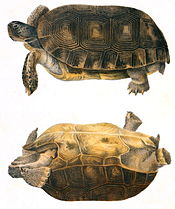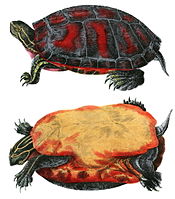- D'Orbigny's slider
-
D'Orbigny's slider 
Conservation status Scientific classification Kingdom: Animalia Phylum: Chordata Class: Reptilia Subclass: Anapsida Order: Testudines Family: Emydidae Genus: Trachemys Species: Trachemys dorbigni[1] D'Orbigny's slider (Trachemys dorbigni) is a species of water turtle found in southern Brazil, northeastern Argentina, and Uruguay.[2]
Contents
REPRODUCTION
A popular way to identify whether the animal is male or female is to examine the format of the plastron. In fact, only terrestrial species after a few years of life show differences between male and female. Males have a penis that is inserted into the tail, it becomes apparent only during the mating season when it is inserted into the female's cloaca. On average 9 eggs are produced at a time. The eggs are buried in a nest dug into the ground. Incubation ranges from 2 to 4 months, and the baby turtles are born weighing 11 grams and 3.5 cm carapace. When they reach sexual maturity in males (who become adults after 2 years) acquire a dark color while the females (which become mature after 5 years) are still green. Males have nails on the front legs which are larger than the females and used in the preparation for mating. The process for which is swimming in front of the female partner and rubbing the tips of his nails in her nose. The sex of baby turtles is determined by the temperature of the sand during incubation: at lower temperatures show the birth of a higher female population.
Diseases
The turtles can catch some diseases such as pneumonia, dystocia, bone decalcification, vitamin deficiencies, gastroenteritis amd prolapses, among others.
Diet
These turtles can eat almost anything: dried shrimps, vegetables, fruit, meat, small fishes, snails, etc.
Legal
This species is considered wildlife and its ownership and maintenance are only allowed with specific documentation. The purchase invoice must contain the popular and scientific name, stating the number of animals recorded at the bottom of the hull, the certificate of origin, invoice number and the number of commercial breeding of wildlife recorded in the Brazilian IBAMA.
References
- ^ Rhodin 2010, p. 000.102
- ^ Ernst, CH; R.G.M. Altenburg & R.W. Barbour. Turtles of the World. http://nlbif.eti.uva.nl/bis/turtles.php?menuentry=soorten&id=323.
- Bibliography
- Rhodin, Anders G.J.; Paul van Dijk, Peter; Inverson, John B.; Shaffer, H. Bradley (2010-12-14). "Turtles of the World 2010 Update: Annotated Checklist of Taxonomy, Synonymy, Distribution and Conservation Status" (pdf). Archived from the original on 2010-12-15. http://www.webcitation.org/5uzfktoIh. Retrieved 2010-12-15.
Order Testudines (turtles) Suborder SuperfamilySubfamily
Cryptodira Chelydra · MacrochelysCaretta · Chelonia · Eretmochelys · Lepidochelys · NatatorDermochelysDermatemydidaeDermatemysStaurotypinaeClaudius · StaurotypusBatagur · Cuora · Cyclemys · Geoclemys · Geoemyda · Hardella · Heosemys · Leucocephalon · Malayemys · Mauremys · Melanochelys · Morenia · Notochelys · Orlitia · Pangshura · Rhinoclemmys · Sacalia · Siebenrockiella · VijayachelysAldabrachelys · Astrochelys · Chelonoidis · Chersina · Cylindraspis · Geochelone · Gopherus · Homopus · Indotestudo · Kinixys · Malacochersus · Manouria · Psammobates · Pyxis · Stigmochelys · TestudoTrionychiaCarettochelyidaeCarettochelysTrionychinaePleurodira ChelidinaeChelodininaeHydromedusinaePelomedusa · PelusiosPhylogenetic arrangement based on turtles of the world 2010 update: annotated checklist. Extinct turtles not included.
See also List of Testudines families
 Portal ·
Portal ·  WikiProjectCategories:
WikiProjectCategories:- IUCN Red List least concern species
- Trachemys
- Turtle stubs
Wikimedia Foundation. 2010.


